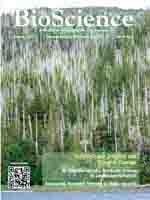Who among us has not marveled at the structure of a feather, the way its barbules can be unzipped and then locked back together to perfectly restore its vanes? Who has not envied the power of flight that the feather gives to a bird? In the book Feathers: The Evolution of a Natural Miracle, author Thor Hanson builds on these common denominators of human experience to take his readers on a broad-ranging tour of what experts know about (and how we make use of) feathers. From basic research about bird biology and the evolutionary origins of feathers to falconry, couture, and bioinspiration in industrial design, the book treats us to a series of engaging essays about feathers, both on and off of the bird.
Hanson is a conservation biologist, as well as an accomplished nature writer, and he has drawn on his scientific training and his extensive field experience in animal behavior and ecology to write Feathers. In the book, Hanson weaves his prior encounters with birds and his experiences as a scientist into the text, offering lively anecdotes about his student days and subsequent life as a professional grantseeking field biologist. He is particularly adept at portraying how science really works: It is about first having an inquisitive mind and then satisfying it by gathering data and experimenting. Ever thus, Hanson has his hands in what he writes about, whether he is pulling the feathers off a road-killed winter wren or taking the temperature of a deceased woodpecker's plumage in both sunshine and shade.
From his current home in the San Juan Islands, where much of the book's action takes place, Hanson tackles an assortment of feather-related topics. But he also interviews experts ranging from fellow scientists to manufacturers of jackets and comforters to feather-clad Las Vegas showgirls, who all offer unique perspectives. Hanson's prose is polished, lively, and evocative. The outcome is a book that is easy and entertaining to read, yet one that is able to satisfy our intellectual curiosity. With Hanson's “up close and personal” approach Archaeopteryx's discovery is revealed from the perspective of a nineteenth-century quarry worker. We then learn more about birds and dinosaurs from the thoughts of a curator of the most recently discovered specimen of Archaeopteryx in Thermopolis, Wyoming. While considering bird flight, we meet a falconer who has clocked his peregrine at 272 miles per hour in a streamlined free dive.
On other occasions, Hanson turns to the wisdom of our scientific predecessors. An explanation of the use of plumage in mating displays is introduced via Alfred Russel Wallace's field observations of birds-of-paradise. The topic of sexual selection by way of female mate choice opens with Charles Darwin's original observations and theories. Hanson also keeps good scientific company when doing research: He contemplates heat retention in tiny golden-crowned kinglets during a Vermont winter while taking Bernd Heinrich's famous winter ecology course. He reaches into a broad-billed prion burrow in the Falkland Islands under the tutelage of seabird expert Peter Harrison. He extensively interviews Richard Prum about his model for feather development and about his theory of the evolutionary stages of feathers. He also interviews Xing Xu about the types of filaments and feathers that are turning up on Mesozoic birds and dinosaurs from China.
One unfortunate aspect of Feathers is that the topic of birds' evolutionary relationship with dinosaurs is, once again, presented as a contentious scientific battle with winners and losers. With all the new fossil material that has come to light in recent years, the study of Mesozoic filaments and feathers and the animals that possessed them is becoming more empirical and inevitably moving away from its past emphasis on argumentation, but this recent shift is not apparent in Feathers.
Much of the book is devoted to human interactions with feathers. Hanson traces the roots of human fascination with feathers, starting with a long-eared owl depicted at Chauvet Cave in southern France. Readers consider the history of feathers used in manufacturing, including fletching on arrows, the once-essential feather quills used for writing, fly tying for trout fishing, and of course clothing and bedding made with astonishingly insulative downy feathers. We learn that manufacturers of waterproof clothing are still trying to decipher how structure alone conveys waterproofing in duck feathers. Although Hanson is a conservationist, the book is far from a conservationist tract. He presents the history of human exploitation of birds with surprising humor, leaving judgment up to the reader. Still, it is a dark chapter that recounts the exploitation of egrets, ostriches, and other birds for women's hats in the late nineteenth and early twentieth centuries, including the obscure fact that the most valuable cargo on the Titanic was 40 cases of fine plumes.
In Feathers, Hanson is remarkably successful at offering something for everyone. Readers from young adults to professional ornithologists and from those interested in nature to those more interested in human culture will enjoy this book. I should add that it is nicely illustrated with black-and-white drawings and includes chapter notes, a bibliography, and an index. Ultimately, Feathers is a book to read for pleasure, but along the way, we gain knowledge and insight into nature and our relationship with it.






